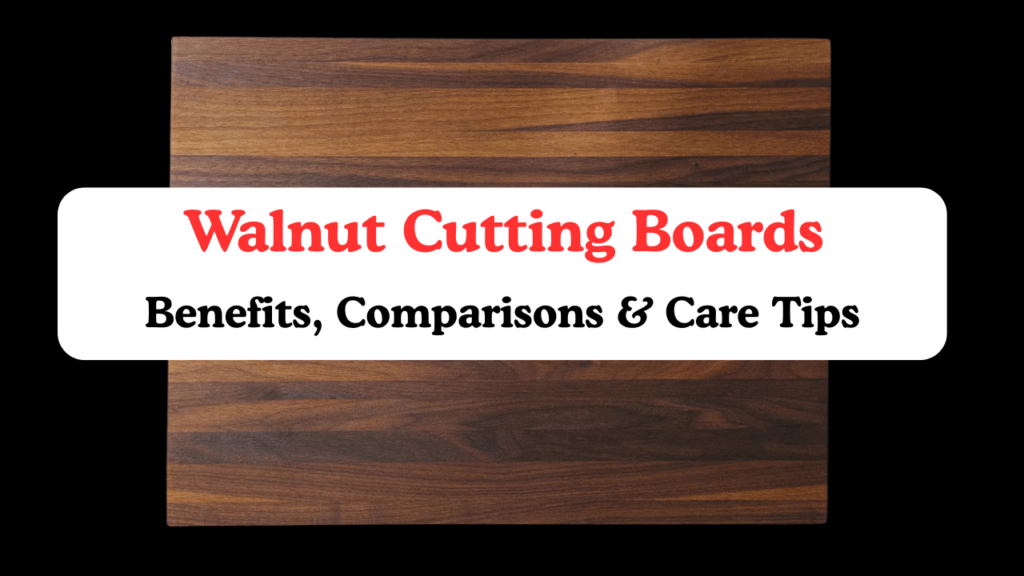
A walnut cutting board is often regarded as one of the most premium options available for home cooks and professional chefs. Known for its rich dark color, durability, and knife-friendly surface, walnut boards are considered both functional and stylish.
Compared to other popular woods like maple, beech, or bamboo, walnut provides a unique balance of elegance, performance, and longevity.
What Is a Walnut Cutting Board?
A walnut cutting board is made from black walnut wood, one of the most beautiful and durable hardwoods in North America. Its deep, chocolate-brown tones with natural grain patterns give it a luxurious appearance that instantly enhances any kitchen. Walnut has been favored for centuries in fine furniture and kitchenware because of its strength, stability, and visual appeal.
Why Walnut Wood Is Good for Cutting Boards
1. Durability and Strength
Walnut wood is recognized as a strong hardwood that withstands daily chopping, slicing, and cutting without wearing down quickly. While slightly softer than maple, walnut’s hardness is ideal because it provides durability while remaining gentle on knife blades.
2. Knife-Friendly Surface
Unlike bamboo or very hard exotic woods, walnut’s medium hardness ensures that knives remain sharp for longer. This makes it a preferred choice for chefs who value the longevity of their blades.
3. Natural Antibacterial Properties
As a hardwood with a closed-grain structure, this walnut naturally resists the bacterial penetration. Its surface does not allow deep cuts to harbor harmful microbes, making it a hygienic option when properly maintained.
4. Moisture Resistance
Walnut boards resist warping and cracking when cleaned and oiled regularly. With proper care, they maintain shape and integrity far better than softer woods.
5. Aesthetic Elegance
One of the biggest reasons walnut boards are chosen is their luxurious dark brown tone and unique wood grain. They often double as serving boards for cheeses, bread, and charcuterie because of their stunning appearance.
6. Eco-Friendly Choice
Walnut trees are sustainably harvested in many regions, making walnut a more eco-conscious option compared to plastic or synthetic cutting boards.
Walnut Cutting Board vs. Other Woods
Walnut vs. Maple Cutting Board: Maple is slightly harder and lighter in color, while walnut offers a darker, richer aesthetic with a gentler surface on knives.
Walnut vs. Beech Cutting Board: Beech is affordable and durable, but walnut provides a premium, luxurious look and often lasts longer with proper care.
Walnut vs. Bamboo Cutting Board: Bamboo is cheaper and harder but it can dull the knives quickly and is also prone to cracking. Walnut offers better stability and knife protection.
Care and Maintenance of Walnut Cutting Boards
To extend the life of a walnut cutting board, proper care should always be followed:
Cleaning: Wash by hand using warm, soapy water. Dishwashers and soaking should be avoided to prevent warping.
Drying: The board should always be dried thoroughly after each wash.
Oiling: Regular oiling with food-grade mineral oil or a mixture of oil and beeswax is recommended. This helps maintain moisture resistance and enhances the wood’s natural color.
Usage: Both sides of the board should be used equally to prevent uneven wear. One side can also be dedicated to food prep and the other for serving.
Why Walnut Cutting Boards Are a Premium Choice
Walnut boards are chosen by professional chefs and home cooks not only for their functionality but also for their visual elegance.
Their dark finish adds sophistication to kitchens, while their performance ensures reliability. Whether used for heavy chopping or elegant serving, walnut delivers both beauty and strength.
Frequently Asked Questions (FAQs) About Walnut Cutting Boards
1. Is walnut wood good for cutting boards?
Yes, walnut is considered excellent for cutting boards. It is durable, gentle on knives, and visually stunning, making it both practical and decorative.
2. Are walnut cutting boards safe for meat?
Yes, walnut cutting boards are safe for meat if properly cleaned and sanitized. However, separate boards are often recommended for raw meat and vegetables to avoid cross-contamination.
3. Does walnut dull knives?
No, walnut is known to be gentle on knives. Its medium hardness helps preserve sharp edges better than bamboo or glass cutting boards.
4. How long does a walnut cutting board last?
With proper care—regular oiling, hand washing, and drying—a walnut cutting board can last for decades without losing its integrity.
5. Which is better: walnut or maple cutting board?
Maple is harder and lighter, while walnut is slightly softer but more knife-friendly and visually elegant. The choice depends on whether durability or aesthetics is prioritized.
6. Is walnut an eco-friendly wood for cutting boards?
Yes, walnut is eco-friendly when harvested sustainably. It is a natural, renewable material that offers a greener alternative to synthetic cutting boards.
Final Thoughts
A walnut cutting board combines premium aesthetics with everyday practicality. Its durability, knife-friendliness, antibacterial nature, and timeless beauty make it a worthy investment for any kitchen. When maintained correctly, it can serve as both a reliable cooking tool and an elegant serving piece.
For anyone looking for a cutting board that blends luxury with functionality, walnut wood stands as one of the finest choices available today.

